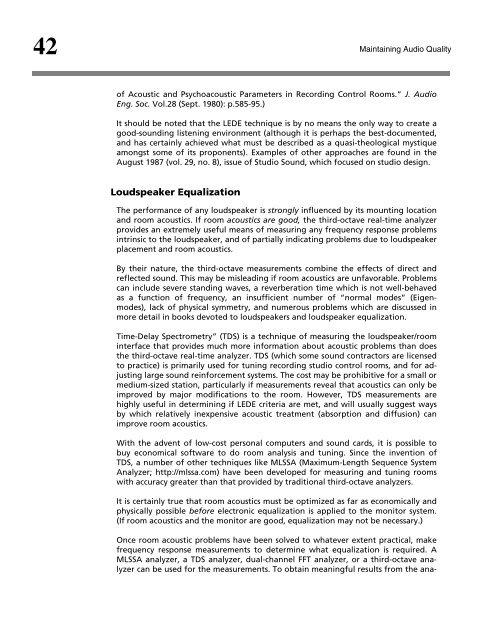Maintaining Audio Quality in the Broadcast Facility 2011 - Orban
Maintaining Audio Quality in the Broadcast Facility 2011 - Orban
Maintaining Audio Quality in the Broadcast Facility 2011 - Orban
Create successful ePaper yourself
Turn your PDF publications into a flip-book with our unique Google optimized e-Paper software.
42<br />
<strong>Ma<strong>in</strong>ta<strong>in</strong><strong>in</strong>g</strong> <strong>Audio</strong> <strong>Quality</strong><br />
of Acoustic and Psychoacoustic Parameters <strong>in</strong> Record<strong>in</strong>g Control Rooms.” J. <strong>Audio</strong><br />
Eng. Soc. Vol.28 (Sept. 1980): p.585-95.)<br />
It should be noted that <strong>the</strong> LEDE technique is by no means <strong>the</strong> only way to create a<br />
good-sound<strong>in</strong>g listen<strong>in</strong>g environment (although it is perhaps <strong>the</strong> best-documented,<br />
and has certa<strong>in</strong>ly achieved what must be described as a quasi-<strong>the</strong>ological mystique<br />
amongst some of its proponents). Examples of o<strong>the</strong>r approaches are found <strong>in</strong> <strong>the</strong><br />
August 1987 (vol. 29, no. 8), issue of Studio Sound, which focused on studio design.<br />
Loudspeaker Equalization<br />
The performance of any loudspeaker is strongly <strong>in</strong>fluenced by its mount<strong>in</strong>g location<br />
and room acoustics. If room acoustics are good, <strong>the</strong> third-octave real-time analyzer<br />
provides an extremely useful means of measur<strong>in</strong>g any frequency response problems<br />
<strong>in</strong>tr<strong>in</strong>sic to <strong>the</strong> loudspeaker, and of partially <strong>in</strong>dicat<strong>in</strong>g problems due to loudspeaker<br />
placement and room acoustics.<br />
By <strong>the</strong>ir nature, <strong>the</strong> third-octave measurements comb<strong>in</strong>e <strong>the</strong> effects of direct and<br />
reflected sound. This may be mislead<strong>in</strong>g if room acoustics are unfavorable. Problems<br />
can <strong>in</strong>clude severe stand<strong>in</strong>g waves, a reverberation time which is not well-behaved<br />
as a function of frequency, an <strong>in</strong>sufficient number of “normal modes” (Eigenmodes),<br />
lack of physical symmetry, and numerous problems which are discussed <strong>in</strong><br />
more detail <strong>in</strong> books devoted to loudspeakers and loudspeaker equalization.<br />
Time-Delay Spectrometry” (TDS) is a technique of measur<strong>in</strong>g <strong>the</strong> loudspeaker/room<br />
<strong>in</strong>terface that provides much more <strong>in</strong>formation about acoustic problems than does<br />
<strong>the</strong> third-octave real-time analyzer. TDS (which some sound contractors are licensed<br />
to practice) is primarily used for tun<strong>in</strong>g record<strong>in</strong>g studio control rooms, and for adjust<strong>in</strong>g<br />
large sound re<strong>in</strong>forcement systems. The cost may be prohibitive for a small or<br />
medium-sized station, particularly if measurements reveal that acoustics can only be<br />
improved by major modifications to <strong>the</strong> room. However, TDS measurements are<br />
highly useful <strong>in</strong> determ<strong>in</strong><strong>in</strong>g if LEDE criteria are met, and will usually suggest ways<br />
by which relatively <strong>in</strong>expensive acoustic treatment (absorption and diffusion) can<br />
improve room acoustics.<br />
With <strong>the</strong> advent of low-cost personal computers and sound cards, it is possible to<br />
buy economical software to do room analysis and tun<strong>in</strong>g. S<strong>in</strong>ce <strong>the</strong> <strong>in</strong>vention of<br />
TDS, a number of o<strong>the</strong>r techniques like MLSSA (Maximum-Length Sequence System<br />
Analyzer; http://mlssa.com) have been developed for measur<strong>in</strong>g and tun<strong>in</strong>g rooms<br />
with accuracy greater than that provided by traditional third-octave analyzers.<br />
It is certa<strong>in</strong>ly true that room acoustics must be optimized as far as economically and<br />
physically possible before electronic equalization is applied to <strong>the</strong> monitor system.<br />
(If room acoustics and <strong>the</strong> monitor are good, equalization may not be necessary.)<br />
Once room acoustic problems have been solved to whatever extent practical, make<br />
frequency response measurements to determ<strong>in</strong>e what equalization is required. A<br />
MLSSA analyzer, a TDS analyzer, dual-channel FFT analyzer, or a third-octave analyzer<br />
can be used for <strong>the</strong> measurements. To obta<strong>in</strong> mean<strong>in</strong>gful results from <strong>the</strong> ana-



![[PDF] Using the ITU BS.1770-2 and CBS Loudness Meters ... - Orban](https://img.yumpu.com/50629372/1/190x245/pdf-using-the-itu-bs1770-2-and-cbs-loudness-meters-orban.jpg?quality=85)






![[PDF] Optimod-FM Feature Comparison - Orban](https://img.yumpu.com/41741615/1/190x245/pdf-optimod-fm-feature-comparison-orban.jpg?quality=85)






